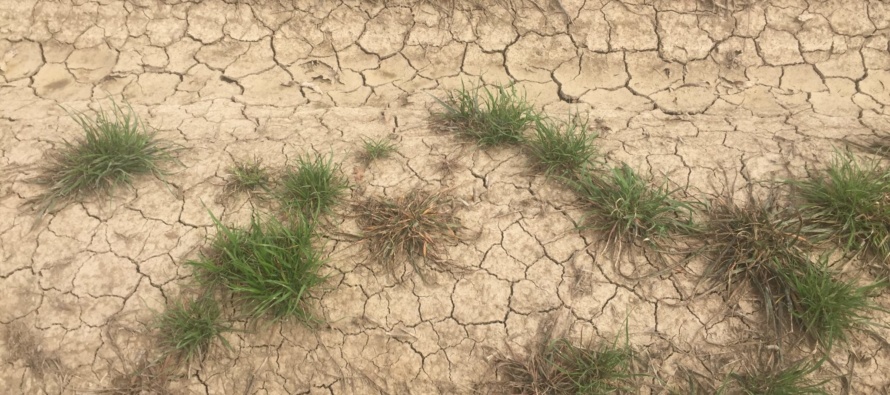Clethodim-resistant Italian Ryegrass in Mississippi

Related Articles
- 2010 Soybean And Corn Variety Trial Data 3
- Rice Variety Trial Results For 2010, Plus Rice Research Report 0
- Evaluation of Peanut Varieties in Mississippi, 2010 0
Latest Tweets
Key Points to Remember:
- Italian ryegrass resistant to clethodim has been confirmed in Mississippi.
- Counties clethodim-resistant Italian ryegrass resistant include Bolivar, Coahoma, Humphreys, Leflore, Sunflower, and Washington.
- Paraquat is the only reliable herbicide for postemergence control of Italian ryegrass control with resistance to clethodim.
 Italian ryegrass has been one of the primary weed problems during burndown in Mississippi for nearly 15 years. Most populations are resistant to the “fop” family of ACCase herbicides due to overuse of Hoelon (diclofop) in wheat. Resistance to ALS herbicides is also widespread across much of Mississippi. Glyphosate resistance was confirmed in 2005, and multiple-resistant Italian ryegrass has been a scourge in Mississippi since that time. Research and field experience have demonstrated that (1) clethodim and paraquat are the only postemergence herbicides that reliably control glyphosate-resistant (GR) Italian ryegrass, (2) fall applications of residual herbicides are the most effective treatments, and (3) multiple herbicide applications are required to approach complete control.
Italian ryegrass has been one of the primary weed problems during burndown in Mississippi for nearly 15 years. Most populations are resistant to the “fop” family of ACCase herbicides due to overuse of Hoelon (diclofop) in wheat. Resistance to ALS herbicides is also widespread across much of Mississippi. Glyphosate resistance was confirmed in 2005, and multiple-resistant Italian ryegrass has been a scourge in Mississippi since that time. Research and field experience have demonstrated that (1) clethodim and paraquat are the only postemergence herbicides that reliably control glyphosate-resistant (GR) Italian ryegrass, (2) fall applications of residual herbicides are the most effective treatments, and (3) multiple herbicide applications are required to approach complete control.
Clethodim has been the primary postemergence herbicide used for control of GR Italian ryegrass in Mississippi for many years. Because the GR Italian ryegrass problem is widespread and because there are few other options, clethodim has often been used multiple times in a single year and in the same field in successive years. Therefore, similar to the evolution of glyphosate resistance, it was only a matter of time before repeated use of the same herbicide selected for Italian ryegrass plants resistant to clethodim.
Control failures with clethodim on GR Italian ryegrass were common across the Mississippi Delta in 2016 and 2017. During both years, Italian ryegrass plants were collected from fields where clethodim failures were observed. These plants were subjected to traditional herbicide response screening by Dr. Vijay Nandula with the USDA-ARS in Stoneville. Results of the screening confirmed that Italian ryegrass resistant to clethodim is present in Mississippi.
 Counties known to contain populations of Italian ryegrass resistant to clethodim include Bolivar, Coahoma, Humphreys, Leflore, Sunflower, and Washington. When GR Palmer amaranth was spreading across Mississippi, the strategy was to assume populations were resistant if resistance had been identified in your county or an adjacent county. A similar approach should be utilized with clethodim-resistant Italian ryegrass. For example, no clethodim-resistant Italian ryegrass populations were confirmed in Tallahatchie County. However, since clethodim resistance was identified in populations from Coahoma, Leflore, and Sunflower counties, Italian ryegrass from Tallahatchie County should be treated as resistant.
Counties known to contain populations of Italian ryegrass resistant to clethodim include Bolivar, Coahoma, Humphreys, Leflore, Sunflower, and Washington. When GR Palmer amaranth was spreading across Mississippi, the strategy was to assume populations were resistant if resistance had been identified in your county or an adjacent county. A similar approach should be utilized with clethodim-resistant Italian ryegrass. For example, no clethodim-resistant Italian ryegrass populations were confirmed in Tallahatchie County. However, since clethodim resistance was identified in populations from Coahoma, Leflore, and Sunflower counties, Italian ryegrass from Tallahatchie County should be treated as resistant.
While multiple-resistant Italian ryegrass is a driver weed for winter burndown applications, it does not exist in a monoculture, so burndown must go on even where Italian ryegrass is present. Because paraquat is the only alternative for postemergence control of Italian ryegrass control and because not every Italian ryegrass plant in a field to be treated will be resistant to clethodim, an early burndown application should include the maximum rate of glyphosate plus 16 ounces of Select Max or 8 ounces of 2-lb clethodim formulation. Auxin herbicides like 2,4-D and/or dicamba may be added to the herbicide mixture if the maximum rate of clethodim is utilized.
Italian ryegrass that escapes the early burndown application should be treated with paraquat (3 to 4 pints of Gramoxone SL or 2 to 2.67 pints of 3-lb paraquat). Large ryegrass (12 to 24 inches) will require two applications of paraquat (4 pints of Gramoxone SL or 2.67 pints of 3-lb paraquat) spaced 10 to 14 days apart. Atrazine, metribuzin, or diuron may be added to paraquat applications in fields to be planted to corn/grain sorghum, soybean, or cotton, respectively.




Let me tell You a sad story ! There are no comments yet, but You can be first one to comment this article.
Write a comment